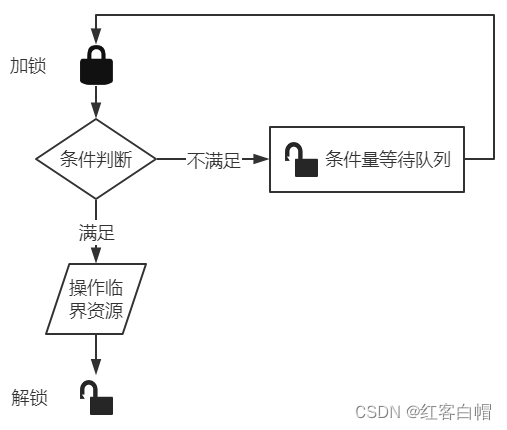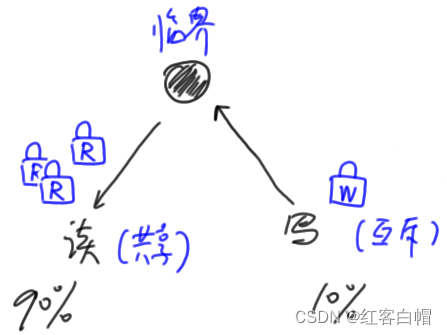活动地址:毕业季·进击的技术er
嵌入式Linux系统编程-》同步互斥机制+面试题+源码
1. 基本概念
互斥与同步是最基本的逻辑概念:
互斥指的是: 控制两个进度使之互相排斥,不同时运行。
同步指的是: 控制两个进度使之有先有后,次序可控。

2. 互斥锁
2.1 基本逻辑
使得多线程间互斥运行的最简单办法,就是增加一个互斥锁。任何一条线成要开始运行互斥区间的代码,都必须先获取互斥锁,而互斥锁的本质是一个二值信号量,因此当其中一条线程抢先获取了互斥锁之后,其余线程就无法再次获取了,效果相当于给相关的资源加了把锁,直到使用者主动解锁,其余线程方可有机会获取这把锁。
2.2 函数接口
定义 互斥锁是一个特殊的变量,定义如下:
#include <pthread>
pthread_mutex_t m;
一般而言,由于互斥锁需要被多条线程使用,因此一般会将互斥锁定义为全局变量。
初始化与销毁
未经初始化的互斥锁是无法使用的,初始化互斥锁有两种办法:
静态初始化
动态初始化
静态初始化很简单,就是在定义同时赋予其初值:
pthread_mutex_t m = PTHREAD_MUTEX_INITIALIZER;
由于静态初始化互斥锁不涉及动态内存,因此无需显式释放互斥锁资源,互斥锁将会伴随程序一直存在,直到程序退出为止。而所谓动态初始化指的是使用
pthread_mutex_init()
给互斥锁分配动态内存并赋予初始值,因此这种情形下的互斥锁需要在用完之后显式地进行释放资源,接口如下:
#include <pthread.h>
// 初始化互斥锁
int pthread_mutex_init(pthread_mutex_t *restrict mutex,
const pthread_mutexattr_t *restrict attr);
// 销毁互斥锁
int pthread_mutex_destroy(pthread_mutex_t *mutex);
接口说明:
`mutex:互斥锁
attr:互斥锁属性(一般设置为NULL)`
加锁与解锁
互斥锁的基本操作就是加锁与解锁,接口如下:
#include <pthread.h>
pthread_mutex_t m = PTHREAD_MUTEX_INITIALIZER;
// 加锁
pthread_mutex_lock( &m );
// 解锁
pthread_mutex_unlock( &m );
示例代码
将此前判断偶数的代码用互斥锁加以改进如下:
// concurrency.c
#include <stdio.h>
#include <stdlib.h>
#include <unistd.h>
#include <time.h>
#include <string.h>
#include <pthread.h>
pthread_mutex_t m = PTHREAD_MUTEX_INITIALIZER;
int global = 100;
void *isPrime(void *arg)
{
while(1)
{
pthread_mutex_lock(&m);
// 一段朴素的代码
if(global%2 == 0)
printf("%d是偶数\n", global);
pthread_mutex_unlock(&m);
}
}
int main()
{
pthread_t tid;
pthread_create(&tid, NULL, isPrime, NULL);
// 一条人畜无害的赋值语句
while(1)
{
pthread_mutex_lock(&m);
global = rand() % 5000;
pthread_mutex_unlock(&m);
}
}
运行结果如下:
gec@ubuntu:~$ ./concurrency
492是偶数
2362是偶数
2778是偶数
3926是偶数
540是偶数
3426是偶数
4172是偶数
112是偶数
368是偶数
2576是偶数
1530是偶数
1530是偶数
2862是偶数
4706是偶数
...
gec@ubuntu:~$
可见,有了互斥锁之后,输出的结果正确了。
3. 读写锁
3.1 基本逻辑
对于互斥锁而言,凡是涉及临界资源的访问一律加锁,这在并发读操作的场景下会大量浪费时间。要想提高访问效率,就必须要将对资源的读写操作加以区分:读操作可以多任务并发执行,只有写操作才进行恰当的互斥。这就是读写锁的设计来源。
读写锁提高了资源访问的效率
定义 与互斥锁类似,读写锁也是一种特殊的变量:
pthread_rwlock_t rw;
初始化
与互斥锁类似,读写锁也分成静态初始化和动态初始化:
#include <pthread.h>
// 静态初始化:
pthread_rwlock_t rw = PTHREAD_RWLOCK_INITIALIZER;
// 动态初始化与销毁:
int pthread_rwlock_init(pthread_rwlock_t *restrict rwlock,
const pthread_rwlockattr_t *restrict attr);
int pthread_rwlock_destroy(pthread_rwlock_t *rwlock);
加锁
读写锁最大的特点是对即将要做的读写操作做了区分:
读操作可以共享,因此多条线程可以对同一个读写锁加多重读锁
写操作天然互斥,因此多条线程只能有一个拥有写锁。(注意写锁与读锁也是互斥的)
#include <pthread.h>
// 读锁
// 1,阻塞版本
int pthread_rwlock_rdlock(pthread_rwlock_t *rwlock);
// 2,非阻塞版本
int pthread_rwlock_tryrdlock(pthread_rwlock_t *rwlock);
// 写锁
// 1,阻塞版本
int pthread_rwlock_wrlock(pthread_rwlock_t *rwlock);
// 2,非阻塞版本
int pthread_rwlock_trywrlock(pthread_rwlock_t *rwlock);
操作原则:
如果只对数据进行读操作,那么就加 → 读锁。
如果要对数据进行写操作,那么就加 → 写锁。
解锁
#include <pthread.h>
int pthread_rwlock_unlock(pthread_rwlock_t *rwlock);
4. POSIX信号量基本概念
POSIX信号量与IPC信号量组中的信号量元素的逻辑完全一样,但POSIX信号量操作更加简便,接口更加易用。在多进程多线程中运用广泛。
POSIX信号量分成两种:
POSIX匿名信号量
通常用在
线程间 只存在于内存,在文件系统中不可见
POSIX具名信号量
通常用在
进程间 存在于文件系统/dev/shm中,可被不同进程操作
5. POSIX匿名信号量
5.1 定义
#include <semaphore.h>
sem_t s;
5.2 初始化
#include <semaphore.h>
int sem_init(sem_t *sem, int pshared, unsigned int value);
接口说明:
sem:待初始化信号量指针
pshared:指定信号量的作用范围
`0:作用于进程内的线程间
非0:作用于进程间`
value:信号量的初始值
示例
sem_t s;
int main()
{
// 初始化POSIX匿名信号量:
// 将其设定为在本进程内的个线程间使用
// 并将其初始值设定为1
sem_init(&s, 0, 1);
}
5.3 P/V 操作
POSIX信号量(不管是匿名的还是具名的)的 P/V 操作相对于systemV的信号量组而言,接口非常简单:
#include <semaphore.h>
int sem_wait(sem_t *sem); // P操作
int sem_post(sem_t *sem); // V操作
接口说明:
P操作即申请资源,因此 sem_wait()在资源不足时会阻塞,而V操作永远不会阻塞。
示例
#include <semaphore.h>
sem_t s;
char buf[100];
void *routine(void *arg)
{
while(1)
{
// 申请信号量-1,输出字符串的长度
sem_wait(&s);
printf("%d\n", strlen(buf));
}
}
int main()
{
// 初始化,信号量初始值为0
sem_init(&s, 0, 0);
pthread_t t;
pthread_create(&t, NULL, routine, NULL);
while(1)
{
fgets(buf, 100, stdin);
// 输入字符串后,释放信号量+1
sem_post(&s);
}
}
6. POSIX具名信号量
POSIX具名信号量主要用在多进程间同步互斥,其P/V操作与匿名版本无异,其最大的特点是存在于文件系统/dev/shm中,可以被系统中任意有权限的进程打开。
6.1 创建和打开
POSIX 具名信号量使用如下接口创建:
#include <fcntl.h> /* For O_* constants */
#include <sys/stat.h> /* For mode constants */
#include <semaphore.h>
sem_t *sem_open(const char *name, int oflag);
sem_t *sem_open(const char *name, int oflag, mode_t mode, unsigned int value);
说明
与文件IO函数 open() 类似,sem_open() 也提供了两个版本,初建时需要指定文件权限 mode 和初始值value,后续再打开使用时则无需指定。
示例
// 在进程 a.c 中创建具名信号量
int main()
{
// 创建有名信号量,参数1代表初始值为1
sem_t *s = sem_open("mysem", O_CREAT, 0666, 1);
}
// 在进程 b.c 中打开具名信号量
int main()
{
// 打开具名信号量
sem_t *s = sem_open("mysem", O_RDWR);
}
编译程序 a.c(注意要加线程库 -lpthread)并运行该程序,便会在系统 /dev/shm/ 产生对应的文件:
gec@ubuntu:~$ gcc a.c -o a -lpthread
gec@ubuntu:~$ ./a
gec@ubuntu:~$ ls -l /dev/shm/
总用量 4
-rw-rw-r-- 1 gec gec 32 Nov 26 18:27 sem.mysem
gec@ubuntu:~$
6.2 P/V 操作
与匿名信号量完全一致:
#include <semaphore.h>
int sem_wait(sem_t *sem); // P操作
int sem_post(sem_t *sem); // V操作
示例
// a.c
int main()
{
sem_t *s = sem_open("mysem", O_CREAT, 0666, 0);
printf("A\n");
sem_post(s); // V操作
}
// b.c
int main()
{
sem_t *s = sem_open("mysem", O_RDWR);
// 等待A执行完毕,才执行B
sem_wait(s); // P操作
printf("B\n");
}
信号量的V操作就像一个远程开关,控制另一个进程的进度:在进程A尚未执行 sem_post(s) 之前,进程B会一直在 sem_wait(s)静静等待,这就是多进程进度控制。
注意,上述程序 a.c 和程序 b.c 是两个独立的程序,彼此之间没有任何共享的变量和数据,他们通过基于文件系统的具名信号量达成协同。
6.3 关闭、删除和其他注意事项
POSIX 具名信号量跟文件操作非常类似,打开之后会在内核需要对其维护,因此在不再需要的时候应该予以关闭:
sem_close(s);
另外,即使所有进程都关闭了信号量并且退出,具名信号量对应的文件是不会消失的,并且会保留所有 P/V操作后的值,如果不再需要这个文件本身,则除了可以直接在文件系统中删除外,也可以使用如下接口删除:
sem_unlink("mysem");
上文提到,具名信号量会将所有的 P/V 操作后的值,因此向上述程序 a.c 如果连续执行三遍,那么信号量的值将会被 +3 ,因此程序 b.c
可以连续进行三次 P 操作。
7. 条件量基本概念
在许多场合中,程序的执行通常需要满足一定的条件,
条件不成熟的时候,任务应该进入睡眠阻塞等待,条件成熟时应该可以被快速唤醒。另外,在并发程序中,会其他任务同时访问该条件,因此任何时候都必须以互斥的方式对条件进行访问。条件量就是专门解决上述场景的逻辑机制。
注意,上述表述中,条件和条件量是两个不同的东西,所谓条件就是指程序要继续运行所需要的前提条件,比如文件是否读完、内存是否清空等具体的场景限定,而条件量(即pthread_cond_t)是本节课件要讨论的一种同步互斥变量,专用于解决上述逻辑场景。

说明:
在进行条件判断前,先加锁(防止其他任务并发访问) 成功加锁后,判断条件是否允许 若条件允许,则直接操作临界资源,然后释放锁
若条件不允许,则进入条件量的等待队列中睡眠,并同时释放锁
在条件量中睡眠的任务,可以被其他任务唤醒,唤醒时重新判定条件是否允许程序继续执行,当然也是必须先加锁。
8. 条件量的使用
条件量一般要跟互斥锁(或二值信号量)配套使用,互斥锁提供锁住临界资源的功能,条件量提供阻塞睡眠和唤醒的功能。
一般流程示例
以取款为例,假设有多个任务可同时访问存款余额 balance,其中某个任务希望从中取出 ¥100 元,并且要求满足如下逻辑:
如果余额中有大于等于100元,则立即取出
如果余额小于100元,则进入睡眠等待
当有别的任务修改了余额时可被唤醒,并继续判定是否可取款
pthread_mutex_t m; // 互斥锁
pthread_cond_t v; // 条件量
// 银行余额(全局变量,意味着有别的进程可随时访问)
extern int balance;
int main()
{
// 1,初始化
pthread_mutex_init(&m, NULL);
pthread_cond_init(&v, NULL);
// 2,对m加锁
pthread_mutex_lock(&m);
// 2,当条件不允许时,进入条件量中睡眠
// 进入睡眠时,会自动对m解锁
// 退出睡眠时,会自动对m加锁
while(balance < 100)
pthread_cond_wait(&v, &m);
// 3,取款
balance -= 100;
// 4,对m解锁
pthread_mutex_unlock(&m);
}
其他任务,可以在适当的时候,通过如下接口来唤醒处于睡眠态的任务:
// 单个唤醒,唤醒第一个进入条件量中睡眠的任务
pthread_cond_signal(&v);
// 集体唤醒,唤醒进入条件量中睡眠的所有任务
pthread_cond_broadcast(&v);

9. 死锁概念
死锁指的是由于某种逻辑问题,导致等待一把永远无法获得的锁的困境。比如最简单的是同一线程,连续对同一锁资源进行加锁,就进入了死锁。

死锁
最简单的死锁示例
pthread_mutex_t m;
int main()
{
pthread_mutex_init(&m, NULL);
// 正常加锁
pthread_mutex_lock(&m);
// 未释放锁前重复加锁,进入死锁状态
pthread_mutex_lock(&m);
// 下面的代码永远无法执行
...
...
}
以上死锁的例子,可以通过仔细检查代码得以避免,但在现实场景中,有些产生死锁的情况是无法避免的,比如如下情形:
一条线程持有一把锁,期间不能屏蔽取消指令 然后又恰巧被取消指令强制终止,此时死锁的产生变得不可避免。
产生死锁示例
void *routine(void *arg)
{
thread_pool *pool = (thread_pool *)arg;
struct task *p;
while(1)
{
// 操作临界资源之前,加锁
pthread_mutex_lock(&pool->lock);
// 条件不允许时,进入条件量等待
while(pool->waiting_tasks == 0 && !pool->shutdown)
pthread_cond_wait(&pool->cond, &pool->lock);
// 条件允许时,操作临界资源
p = pool->task_list->next;
pool->task_list->next = p->next;
pool->waiting_tasks--;
// !!! 注意 !!!
// 线程若恰好在此处被意外终止,将导致死锁
// 解锁
pthread_mutex_unlock(&pool->lock);
// 其他操作
pthread_setcancelstate(PTHREAD_CANCEL_DISABLE, NULL);
(p->do_task)(p->arg);
pthread_setcancelstate(PTHREAD_CANCEL_ENABLE, NULL);
free(p);
}
pthread_exit(NULL);
}
上述代码中,若线程在中间被取消,则导致死锁。对于这种情况,一个可行的解决办法是:
提前准备一个解锁处理函数,并将其压入线程专用的函数栈中备用。 准备操作临界资源,加锁 操作临界资源
重点:
若线程在此期间意外终止,则会自动调用处理函数解锁 解锁 在函数栈中弹出处理函数。
说明:
上述做法实际上相当于现实生活中的立遗嘱,因为人去世之后是无法再做任何事情的,因此为了防止死亡在关键阶段意外到来,可以在提前立遗嘱,万一不幸遇到该情况就有了预案(处理函数),但如果并未发生此种情形,那么就将遗嘱作废(弹出处理函数且不执行)即可。
根据以上思路,可将上述代码改良为如下代码:
// 意外处理函数:
// 自动解锁
void handler(void *arg)
{
pthread_mutex_unlock((pthread_mutex_t *)arg);
}
void *routine(void *arg)
{
thread_pool *pool = (thread_pool *)arg;
struct task *p;
while(1)
{
/*
** push a cleanup functon handler(), make sure that
** the calling thread will release the mutex properly
** even if it is cancelled during holding the mutex.
**
** NOTE:
** pthread_cleanup_push() is a macro which includes a
** loop in it, so if the specified field of codes that
** paired within pthread_cleanup_push() and pthread_
** cleanup_pop() use 'break' may NOT break out of the
** truely loop but break out of these two macros.
** see line 56 below.
*/
//================================================//
pthread_cleanup_push(handler, (void *)&pool->lock); // 提前准备好意外处理函数
pthread_mutex_lock(&pool->lock);
//================================================//
// 1, no task, and is NOT shutting down, then wait
while(pool->waiting_tasks == 0 && !pool->shutdown)
pthread_cond_wait(&pool->cond, &pool->lock);
// 2, no task, and is shutting down, then exit
if(pool->waiting_tasks == 0 && pool->shutdown == true)
{
pthread_mutex_unlock(&pool->lock);
pthread_exit(NULL); // CANNOT use 'break';
}
// 3, have some task, then consume it
p = pool->task_list->next;
pool->task_list->next = p->next;
pool->waiting_tasks--;
//================================================//
pthread_mutex_unlock(&pool->lock);
pthread_cleanup_pop(0); // 弹出处理函数且不执行
//================================================//
pthread_setcancelstate(PTHREAD_CANCEL_DISABLE, NULL);
(p->do_task)(p->arg);
pthread_setcancelstate(PTHREAD_CANCEL_ENABLE, NULL);
free(p);
}
pthread_exit(NULL);
}
注意:
pthread_cleanup_push()用于将处理函数填入栈中,在线程意外终止后会被自动调用。
pthread_cleanup_pop()用于将栈中的处理函数弹出,若参数为0则意味着不执行,参数不为零则意味着执行该函数。
pthread_cleanup_push() 和 pthread_cleanup_pop() 必须成对出现。
点击下载完整示例代码:pthread_cleanup.c
#include <stdio.h>
#include <stdlib.h>
#include <stdbool.h>
#include <unistd.h>
#include <signal.h>
#include <sys/stat.h>
#include <sys/types.h>
#include <errno.h>
#include <pthread.h>
pthread_mutex_t m = PTHREAD_MUTEX_INITIALIZER;
void *count(void *arg)
{
int i=1;
while(1)
{
sleep(1);
printf("sec: %d\n", i++);
}
}
void handler(void *arg)
{
printf("[%u] is cancelled.\n", (unsigned)pthread_self());
pthread_mutex_t *pm = (pthread_mutex_t *)arg;
pthread_mutex_unlock(pm);
}
void *routine(void *arg)
{
#ifdef CLEANUP
pthread_cleanup_push(handler, (void *)&m);
#endif
pthread_mutex_lock(&m);
printf("[%u] lock the mutex!\n", (unsigned)pthread_self());
/*
** During sleep(), if the calling thread received a cancel-
** request and HASN'T established any cleanup handlers to
** unlock the mutex, it will leave the mutex a DEAD-LOCK
** state.
*/
sleep(2);
printf("[%u]: job finished!\n", (unsigned)pthread_self());
pthread_mutex_unlock(&m);
printf("[%u] unlock the mutex!\n", (unsigned)pthread_self());
/*
** NOTE:
**
** pthread_cleanup_push() and pthread_cleanup_pop() may be
** implemented as macro that expand to text containing '{'
** and '}', respectively. For this reason, the caller must
** user them pairly and ensure that they are paired within
** a same function and at the same lexical nesting level.
*/
#ifdef CLEANUP
pthread_cleanup_pop(0);
#endif
pthread_exit(NULL);
}
int main(int argc, char **argv)
{
pthread_t t, t1, t2;
pthread_create(&t, NULL, count, NULL);
pthread_create(&t1, NULL, routine, NULL);
pthread_create(&t2, NULL, routine, NULL);
printf("[%u] ==> t1\n", (unsigned)t1);
printf("[%u] ==> t2\n", (unsigned)t2);
printf("[%u] ==> main\n", (unsigned)pthread_self());
sleep(1);
pthread_cancel(t1);
pthread_cancel(t2);
sleep(2);
pthread_mutex_lock(&m);
printf("[%u] locked the mutex!\n",
(unsigned)pthread_self());
pthread_mutex_unlock(&m);
exit(0);
}
10.问题
1. 问:老师,POSIX信号量跟之前学的信号量组有什么区别?
答:
逻辑上是一样的,他们都是用来协调任务间同步和互斥的机制,也被译为信号灯,作用就跟控制十字路口的红绿灯一样,防止各个方向的汽车无序争抢道路资源而导致交通事故。
他们的主要区别在于,POSIX信号量(不管是匿名的还是具名的)都是单个定义和操作的,因此POSIX信号量只能协同单一的资源,但单一的资源进行
P/V 操作,而systemV的信号量组,可以同时对一组资源同时原子性地进行 P/V 操作。
11.面试题
编写一个多线程程序,让其中一条线程扮演父母(parent),其余线程扮演子女(chilren)。
父母和所有子女共有一个银行账号,可同时对余额存取款。
父母可随时往账户存入款项,并通过条件量通知子女。
子女可随时从账户取出款项,但必须保证账户数额正确、安全。
余额不可为负数。
取款数额最少是 ¥100 元。
参考代码
#include <pthread.h>
#include <string.h>
#include <unistd.h>
#include <stdlib.h>
#include <stdio.h>
// 银行余额
int balance = 0;
pthread_mutex_t m;
pthread_cond_t v;
// 辅助线程:显示程序流逝时间
void *count_times(void *args)
{
int i = 1;
while(1)
{
sleep(1);
fprintf(stderr, "second: %d\n", i++);
}
pthread_exit(NULL);
}
void *routine(void *args)
{
/* ====================== */
pthread_mutex_lock(&m);
/* ====================== */
/*
** NOTE: whenever pthread_cond_wait() returns, it
** indicates that the calling thread is holding
** the mutex. So we need to unlock the mutex.
*/
while(balance < 100)
pthread_cond_wait(&v, &m);
fprintf(stderr, "t%d: balance = %d\n", (int)args, balance);
balance -= 100;
/* ====================== */
pthread_mutex_unlock(&m);
/* ====================== */
pthread_exit(NULL);
}
int main(int argc, char **argv)
{
if(argc != 2)
{
printf("请指定子女线程数量\n");
exit(0);
}
pthread_mutex_init(&m, NULL);
pthread_cond_init(&v, NULL);
pthread_t tid;
pthread_create(&tid, NULL, count_times, NULL);
/* create a set of threads */
int i, thread_nums = atoi(argv[1]);
for(i=0; i<thread_nums; i++)
pthread_create(&tid, NULL, routine, (void *)i);
/*
** sleep(1) makes sure that the thread-routine
** will lock the mutex first, then condition variable
** cause the thread to be suspended.
**
** sleep(3) will indicate that pthread_cond_wait()
** won't return even if the condition varialble has been
** changed. Thus, the condition variable is NOT associated
** with a specified condition.
**
** Actually, pthread_cond_wait() calling threads will
** be waken up ONLY IF someone calls pthread_cond_signal()
** or pthread_cond_broadcast() and mutex is accessable.
** therefore, pthread_cond_wait() calling thread should
** test critical source again after pthread_cond_wait()
** returned, because it may be changed by anther thread
** which access the mutex first
*/
sleep(1);
pthread_mutex_lock(&m);
balance += 300;
/*
** pthread_cond_signal() will wake up the first thread in
** the condition waiting-queue, while pthread_cond_broadcast()
** wake up all threads which are waiting in the queue.
**
** NOTE: pthread_cond_signal() and pthread_cond_broadcast()
** won't wake up the waiting thread immediately, it only
** wake up one(or them) in the condition-variable waiting
** queue.
**
** NOTE: POSIX doesn't require to own mutex before the calling
** thread calls pthread_cond_signal() or pthread_cond_broadcast()
*/
pthread_cond_broadcast(&v);
//pthread_cond_signal(&v);
sleep(3);
pthread_mutex_unlock(&m);
pthread_exit(NULL);
/*
** exit() or return in main() will cause the whole thread group
** terminate.
*/
// return 0;
}
活动地址:毕业季·进击的技术er
